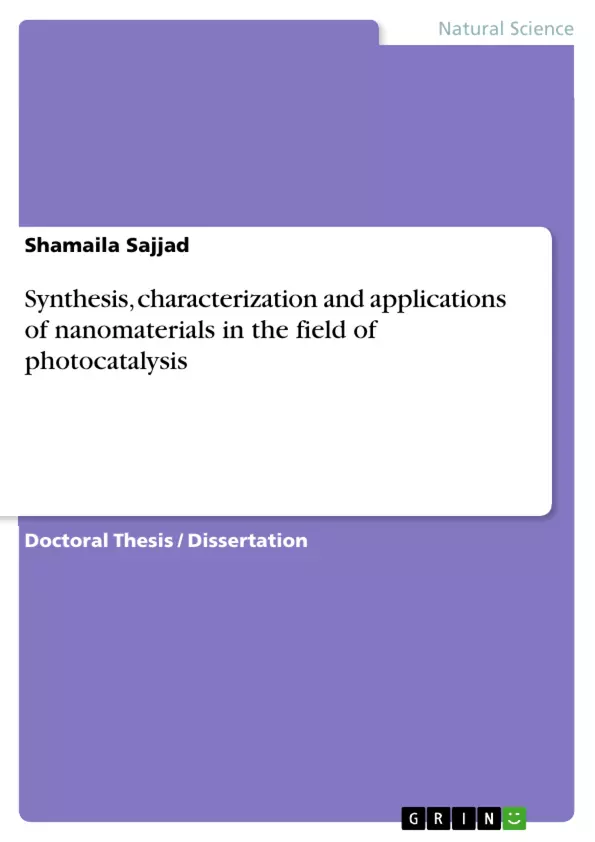Considerable effort has been made to design, fabricate, and manipulate nanostructured
materials by innovative approaches. The precise control of nanoscale structures will pave the
way not only for elucidating unique size/shape dependent physicochemical properties but also
for realizing new applications in science and technology. Nanotechnology offers
unprecedented opportunities for improving our daily lives and the environment in which we
live.
This thesis mainly describes recent progress in the design, fabrication, and modification
of nanostructured semiconductor materials for environmental applications. The scope of this
thesis covers TiO2, Bi2O3 and BiOCl materials, focusing particularly on TiO2-based
nanostructures (e.g., pure, doped, coupled, mesoporous, hierarchically porous, and ordered
mesoporous TiO2).
Mesoporous titania is of particular interest since this class of materials possesses
well-defined porosity and large specific surface areas. For photocatalytic degradation of
organics, these desirable properties are anticipated to improve the efficiency. So in the first
part of work, I have synthesized the mesoporous titania by using poly ethylene glycol as a
template in dilute acetic acid aqueous solution by hydrothermal process and investigated the
effect of PEG molecular weights and thermal treatment on the resultant structure and
photocatalytic activity. When the molecular weights of PEG vary from 600 to 20,000, the
particle sizes of mesoporous-TiO2 structure decrease from 15.1 to 13.3 nm and mean pore
sizes increase from 6.9-10.6 nm. The activities of these mesoporous-TiO2 photocatalysts
prepared by using PEG are evaluated and compared with Degussa P-25 using chloro-phenol
as a testing compound. [...]
Inhaltsverzeichnis (Table of Contents)
- ABSTRACT
- CHAPTER 1
- INTRODUCTION
- 1.1 NANOTECHNOLOGY
- 1.2 BACKGROUND OF TIO2
- 1.2.1 POLYMORPHIC FORMS OF TIO2
- 1.2.2 PHOTOCHEMICAL MECHANISM
- 1.2.3 APPLICATIONS OF TIO2
- 1.3 MODIFICATIONS OF TIO2 PROPERTIES
- 1.3.1 MODIFICATIONS OF TIO2 BY COUPLING OF SEMICONDUCTOR
- 1.3.2 MODIFICATIONS OF TIO2 BY DOPING
- 1.3.3 MODIFICATIONS OF TIO2 BY BISMUTH OXIDE
- 1.3.4 MODIFICATIONS OF TIO2 BY COPPER OXIDE
- 1.3.5 MESOPOROUS MATERIALS
- 1.3.6 HIERARCHICALLY POROUS NANOARCHITECTURES
- 1.4 PREPARATION METHODS
- 1.4.1 SOL-GEL PROCESS
- 1.4.2 HYDROTHERMAL PROCESS
- 1.4.3 THE EVAPORATION INDUCED SELF ASSEMBLY METHOD
- 1.5 BISMUTH OXYCHLORIDES
- 1.6 BISMUTH OXIDE
- 1.7 SURFACE MODIFICATIONS
- 1.8 SPECIFIC OBJECTIVES OF WORK
- CHAPTER 2
- SYNTHESIS AND CHARACTERIZATION OF MESOPOROUS TIO2 WITH ENHANCED PHOTOCATALYTIC ACTIVITY FOR THE DEGRADATION OF CHLORO-PHENOL
- 2. 1. INTRODUCTION
- 2.2.1 MATERIALS AND APPARATUS
- 2.2.2 CATALYST PREPARATION
- 2.2.3 CHARACTERIZATION
- 2.2.4 MEASUREMENTS OF PHOTOCATALYTIC ACTIVITIES OF CHLORO-PHENOL
- 2. 3 RESULTS AND DISCUSSION
- 2.3.1 X-RAY DIFFRACTION SPECTROSCOPY
- 2.3.2 N2 ADSORPTION-DESORPTION
- 2.3.3 SCANNING ELECTRON MICROSCOPY
- 2.3.4 TRANSMISSION ELECTRON MICROSCOPY
- 2.3.5 CHEMICAL REACTIONS MECHANISM FOR THE FORMATION OF POROUS STRUCTURE
- 2.3.6 PHOTOCATALYTIC DEGRADATION OF CHLORO-PHENOL
- 2.3.7 MECHANISM OF PHOTODEGRADATION
- 2.4 CONCLUSIONS
- CHAPTER 3
- MESOPOROUS TITANIA WITH HIGH CRYSTALLINITY DURING SYNTHESIS BY DUAL TEMPLATE SYSTEM AS AN EFFICIENT PHOTOCATALYST
- 3.1 INTRODUCTION
- 3.2 EXPERIMENTAL SECTION
- 3.2.1 MATERIALS AND APPARATUS
- 3.2.2 SYNTHESIS OF MESOPOROUS TIO2
- 3.2.3 CHARACTERIZATION
- 3.2.4 PHOTOCATALYTIC ACTIVITY OF PHENOL
- 3.3 RESULTS AND DISCUSSION
- 3.3.1 THERMOGRAVIMETRIC ANALYSIS
- 3.3.2 X-RAY DIFFRACTION
- 3.3.3 THERMAL STABILITY
- 3.3.4 N2 SORPTION DATA
- 3.3.5 TRANSMISSION ELECTRON MICROSCOPE
- 3.3.6 PHOTOCATALYTIC ACTIVITIES
- 3.3.7 MECHANISM FOR PHENOL DEGRADATION
- 3.4 CONCLUSIONS
Zielsetzung und Themenschwerpunkte (Objectives and Key Themes)
This thesis investigates the synthesis, characterization, and application of nanostructured materials in the field of photocatalysis, focusing primarily on TiO2-based nanomaterials. The primary objective is to enhance the photocatalytic activity of TiO2 for environmental applications by optimizing its structure and properties through various modification techniques.
- Synthesis and characterization of mesoporous TiO2 with enhanced photocatalytic activity.
- Modification of TiO2 properties through doping with various elements (e.g., bismuth, copper).
- Development of visible light active photocatalysts based on TiO2 and BiOCI.
- Investigation of the influence of mesoporosity, hierarchical structures, and doping on photocatalytic performance.
- Evaluation of photocatalytic activity through the degradation of various organic pollutants.
Zusammenfassung der Kapitel (Chapter Summaries)
Chapter 1 provides a comprehensive introduction to the field of nanotechnology, focusing specifically on TiO2 and its applications in photocatalysis. It discusses different polymorphs of TiO2, the photochemical mechanism of photocatalysis, and various methods for modifying TiO2 properties, including doping and the synthesis of mesoporous and hierarchically porous structures.
Chapter 2 explores the synthesis of mesoporous TiO2 using poly ethylene glycol as a template and investigates the effect of varying PEG molecular weights on the structure and photocatalytic activity of the resulting material. The chapter further analyzes the photocatalytic degradation of chloro-phenol using the synthesized mesoporous TiO2 and compares its performance with Degussa P-25.
Chapter 3 delves into the synthesis of highly crystalline mesoporous TiO2 using a dual template system consisting of pluronic P123 and poly ethylene glycol. The chapter evaluates the thermal stability and photocatalytic activity of the synthesized material for the degradation of phenol, highlighting the impact of biporous mesostructure on its performance.
Schlüsselwörter (Keywords)
The research focuses on the synthesis, characterization, and applications of nanomaterials, particularly TiO2-based nanostructures, for photocatalytic applications. Key terms and concepts include mesoporous TiO2, bismuth doping, copper doping, BiOCI, hierarchical macro/mesoporous structures, and visible light photocatalysis.
- Citation du texte
- Shamaila Sajjad (Auteur), 2011, Synthesis, characterization and applications of nanomaterials in the field of photocatalysis, Munich, GRIN Verlag, https://www.grin.com/document/175947



